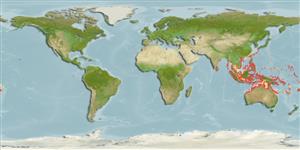>
Kurtiformes (Nurseryfishes, cardinalfishes.) >
Apogonidae (Cardinalfishes) > Apogoninae
Etymology: Taeniamia: Name from feminine Latin noun 'taenia' meaning ribbon or band; and feminine Greek noun 'Amia' meaning a fish, often used with cardinalfishes genera. Here as Taeniamia referring to the vertical wide bars and near vertical to curved narrow bars as lines on most of the species in this genus.
More on author: Bleeker.
Environment: milieu / climate zone / intervalo de profundidade / distribution range
Ecologia
marinhas associadas(os) a recifes; intervalo de profundidade 1 - 40 m (Ref. 54391), usually 2 - 15 m (Ref. 90102). Tropical; 30°N - 23°S
Western Pacific: from Indonesia to Vanuatu, north to the Ryukyu Islands, south to Australia.
Tamanho / Peso / Idade
Maturidade: Lm ? range ? - ? cm
Max length : 8.0 cm TL macho/indeterminado; (Ref. 9710); common length : 6.1 cm SL macho/indeterminado; (Ref. 37816)
Descrição breve
Chaves de identificação | Morfologia | Morfometria
Espinhos dorsais (total) : 7; Raios dorsais moles (total) : 9; Espinhos anais: 2; Raios anais moles: 14 - 16. Diagnosis: Rays: dorsal VI + I,9; anal II,14-16 (rarely 13 or 17); pectoral rays 13-14 (rarely 12). Gill rakers 5-7 + 14-17 (total, 19-23). Lateral-line scales 25+3-4 (rarely 27 or 30). Median predorsal scales 6-7 (rarely 5). Body depth 2.5-2.8 in SL; body width 2.3-2.65 in body depth; eye diameter 2.7-3.2 in head length; first dorsal spine 1.5-1.9 in second spine; second dorsal spine 2.35-3.0, and third dorsal spine 2.35-3.1 in head length; spine of second dorsal fin 2.2-2.6, and second anal spine 2.5-3.1 in head length; pelvic-fin length 4.5-5.1; caudal-peduncle length 4.5-5.4 in SL. Distance from insertion of pelvic spine to anal-fin origin 4.1-5.5 in SL Preopercular edge serrate. Scaly sheath along anal-fin base moderately developed (Ref. 54391).
Some geographical variations. Usually a black band below second dorsal fin, but highly variable in width and may fade to barely a trace, or is completely absent. In Japanese and Indian Ocean populations, the band is usually narrow and often absent. Best identified by the two vertical orange stripes over gills and distinctive black peduncular spot (Ref. 48635).
Body shape (shape guide): short and / or deep; Cross section: compressed.
Forms dense aggregations above or among the branches of Porites cylindrica and other branching corals (e.g. Acropora Ref. 54391) of sheltered lagoons and inshore bays (Ref. 1602); over sandy bottom at depths of 1-40 meters (Ref. 54391). Nocturnal species (Ref. 7300).
Life cycle and mating behavior
Maturidade | Reprodução | Desova | Ovos | Fecundidade | Larvas
Are mouthbrooders (Ref. 240). Distinct pairing during courtship and spawning (Ref. 205).
Gon, O. and J.E. Randall, 2003. Revision of the Indo-Pacific cardinalfish genus Archamia (Perciformes: Apogonidae), with description of a new species. Indo-Pac. Fish. (35):49 p. (Ref. 54391)
Categoria na Lista Vermelha da IUCN (Ref. 130435: Version 2025-1)
Ameaça para o homem
Harmless
Utilização humana
Ferramentas
Relatórios especiais
Descarregue XML
Fontes da internet
Estimates based on models
Preferred temperature (Ref.
123201): 26.1 - 29.3, mean 28.7 °C (based on 2277 cells).
Phylogenetic diversity index (Ref.
82804): PD
50 = 0.5001 [Uniqueness, from 0.5 = low to 2.0 = high].
Bayesian length-weight: a=0.01318 (0.00698 - 0.02491), b=3.02 (2.86 - 3.18), in cm total length, based on LWR estimates for this species & (Sub)family-body (Ref.
93245).
Nível Trófico (Ref.
69278): 3.5 ±0.50 se; based on food items.
Resiliência (Ref.
120179): Elevada, tempo mínimo de duplicação da população menor que 15 meses (Preliminary K or Fecundity.).
Fishing Vulnerability (Ref.
59153): Low vulnerability (10 of 100).
🛈
Nutrients (Ref.
124155): Calcium = 174 [85, 306] mg/100g; Iron = 1.13 [0.62, 2.03] mg/100g; Protein = 18.6 [17.3, 19.8] %; Omega3 = 0.135 [0.070, 0.263] g/100g; Selenium = 36.8 [16.9, 75.9] μg/100g; VitaminA = 53.8 [14.3, 202.5] μg/100g; Zinc = 1.97 [1.25, 3.01] mg/100g (wet weight);
